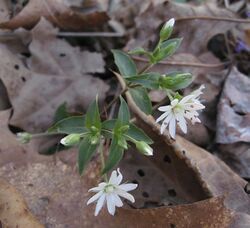Biology:Stellaria pubera
| Star chickweed | |
|---|---|

| |
| Scientific classification | |
| Kingdom: | Plantae |
| Clade: | Tracheophytes |
| Clade: | Angiosperms |
| Clade: | Eudicots |
| Order: | Caryophyllales |
| Family: | Caryophyllaceae |
| Genus: | Stellaria |
| Species: | S. pubera
|
| Binomial name | |
| Stellaria pubera Michx.
| |
Stellaria pubera, commonly called the star chickweed,[2] is a spring-flowering plant in the carnation family Caryophyllaceae, native to the eastern United States.[3]
Habitat and range
Stellaria pubera is widespread and common.[1] Its natural habitat is bottomland forests and mesic forests,[4] where it is often found on rocky slopes.[5] It is found chiefly from Pennsylvania south to Georgia and west to Indiana and Alabama, with scattered populations in New York, New England, Illinois, Nebraska, Mississippi and Louisiana.[3]
Description
An early spring bloomer, star chickweed may be seen in flower as early as late March.
It grows 6 inches (15 cm) to 12 inches (30 cm) high. The leaves are ovate, growing opposite one another and usually attached without stalks to the weak and sometimes reclining stem. Close examination of the flower reveals that what appears to be ten petals are actually five, each deeply cleft. The blossom as a result looks star-like, with its white, pointed petal segments surrounding an off-white center. Stamens are tipped with dark anthers. The stem has rows of small soft hairs that switch sides at each node.[6]
It is similar to Stellaria corei, with which it can easily be confused.[6]
Etymology
The star-shaped flowers of star chickweed inspired the common and Latin name for this flower. The genus name, Stellaria, comes from the Latin stella, meaning "star". The species name, pubera ("hairy"), comes from the lines of hairs that line the stem.
Conservation
Star chickweed is endangered in the state of New Jersey.[7]
References
- ↑ 1.0 1.1 "Stellaria pubera". NatureServe. http://www.natureserve.org/explorer/servlet/NatureServe?searchName=Stellaria+pubera+.
- ↑ "Stellaria pubera". Natural Resources Conservation Service PLANTS Database. USDA. https://plants.usda.gov/core/profile?symbol=STPU.
- ↑ 3.0 3.1 "Stellaria pubera", County-level distribution map from the North American Plant Atlas (NAPA) (Biota of North America Program (BONAP)), 2014, http://bonap.net/MapGallery/County/Stellaria%20pubera.png, retrieved 16 January 2017
- ↑ "Flora of the Southern and Mid-Atlantic States". http://www.herbarium.unc.edu/flora.htm.
- ↑ Newcomb, Lawrence (1977). Newcomb's Wildflower Guide. Little, Brown. pp. 274–275. ISBN 0316604429.
- ↑ 6.0 6.1 Flora of North America Flora of North America
- ↑ "List of Endangered Plant Species and Plant Species of Concern". New Jersey Department of Environmental Protection. http://www.nj.gov/dep/parksandforests/natural/heritage/jan2010plantlist.pdf.
Wikidata ☰ Q7607225 entry
 |


